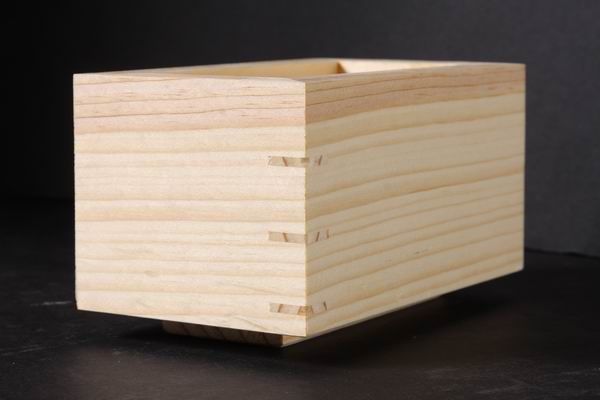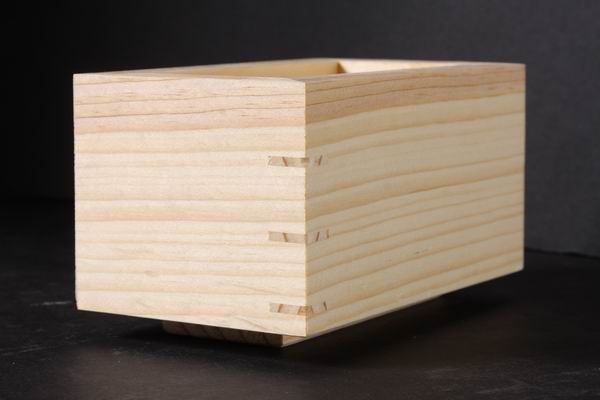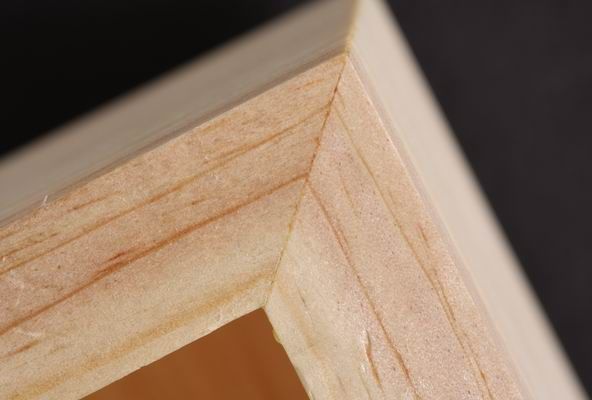
I'm happy with the way the miters came together for this box. A pair of tablesaw sleds - one for the miters, another for the key slots - helped me cut the joinery. And yes - I only cut the keys into one corner.
Need your help figuring out to do with this small box, which I made from scrap pine in my shop last week. It has no lid, and the interior dimensions are 4 1/4 in. by 1 7/8 in. by 2 3/8 in. deep. This make it useful for…what exactly? I thought it might make a nice tabletop caddy for small salt and pepper shakers, but I’m not completely sold on that idea, and I’m open to suggestions. So please fire away.
I didn’t really have a use in mind when I made the box. I just wanted to practice my miters for the flag case that I wrote about recently. To help make sure the mitered ends are cut squarely, I made a dedicated miter sled for my tablesaw like the one recommended by Gary Rogowski in issue #162. It made a huge difference for me in getting miters that mate fully over their entire length.
I also experimented with using keys from the same stock, for a low-contrast look. I want to use a keyed miter at the top of the flag case, but I don’t want it to be too showy. I’m afraid the pine-on-pine look turned out a little too low-contrast, though.
I also discovered, the hard way, that it’s best to plane away from the corners when trimming those keys flush. Otherwise they tend to chip out a bit at the very corners. That’s something I’d have known ahead of time if I’d read Rogowski a little more closely.
Anyway, soon enough I’ll stop practicing and find some nice cherry to make that case. Until then, thanks for reading!

























Comments
He Steven,
Got a solution for you... Take a piece of ebony or other dark wood you have lying around, make a couple of slanted (3%- 5%) holes in it with a slight taper coinciding with your nicest pens (or turn a couple from the same wood) and you have a piece that will be discussed each time someone comes into your office... Did you make that will be the most asked question and it wil remind you of your labours outside of you editors office or cubicle.
Cheerio..
Pascal
Pascal,
I think you might be onto something there. It's funny, because I've been tossing pens into it while it sits here on my desk, but they don't know whether to lie down or stand up, and the whole affair winds up looking a little sloppy. Your idea is a touch of class - thanks!
There's more than one way to skin a cat, but all of them get the job done. Some might be better than others, but there are reasons for that. Someone might do it just to get it done. Then think "there, what's next"? Others will have something in mind for the end product. "Now, this will work perfectly for...." I have a few tidbits to perhaps help you with your craft.
Now that you have a box, let's think outside of it. What's wrong with it? The problem is the opening is too large for such small items. If you want to store pens, how can you make that happen and still be pleasant to the eye? Did you really take a moment to think about it or give up and pose the question here? Pascal quickly came up with a solution. Woodworkers need to think about function. How can I make that work? Well, how about you partition the inside so that your pens, rule, letter opener etc. stay upright and organized?
I understand that you are new to wood working and practicing. I have seen men at the driving range "practicing". They get up and start swinging away at the golf ball and go through a bucket in 5 minutes. There is no thought in their mind as to what they are doing, so essentially they are exercising. To learn, which is the whole reason to practice, you must organize your thought process. How can I take the skills I have now and improve them to do something at a higher level.
You are practicing with pine. Why? There is a big difference working with soft and hard woods. My recommendation: practice with a wood you will want to use. You could start with the partitions. The contrast might be nice. But, bare in mind that the two species will expand and contract differently with changes in the climate. How might you overcome that? Well, you could make the partitions look like Swiss cheese. That would help with expansion, but what about function? What direction will you need to have the grain so expansion will not hurt the structure?
Leads to my next recommendation. I suggest you read up on wood, how it reacts to humidity, how to use grain to your advantage and how to "display" the grain in your work. I spend just as much time examining a piece of lumber as I do working it. The end result however, is worth every moment. Study some antique furniture for grain patterns. How did that wood worker bring out the natural beauty of the wood? Ask, why did he/she use that type of joint. The more questions you ask, the more you think and reason, the better your results.
Finally, I suggest to practice making something with utility in mind. Why build a box with no practical use? That's going through the motions, not using all of your senses and both sides of your brain to "create" something with significance. The flag case for example... This will be the most significant container/piece you will ever make. I can't think of anything that could top it. How can you get from where you are, making a box with no dimensions in mind...to making a box to store a specific triangle? How can you make a case that will "add to" the immense significance of the American Flag..., a soldier's burial flag? That's your goal. It's a big one and you need to make planned steps to get there.
Hope this might help you take on the important task.
Tom Sawyer
sawyeredu
Log in or create an account to post a comment.
Sign up Log in